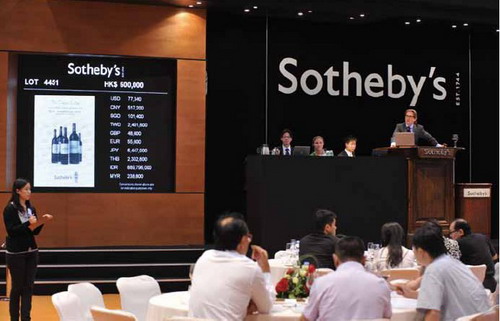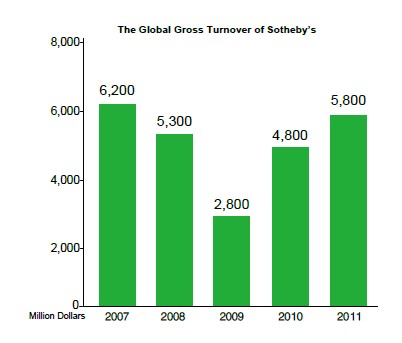Auction is a special type of commodity transaction in the human society. It first appeared in ancient Rome, and became an industry in Europe in the 17th and 18th century. After hundreds of years of development with the market economy, the ancient but burgeoning industry is spreading its unique charm around the globe. And it’s inevitable that it is encountering some IP problems.

With the growth of the world economy, the auction industry has also entered its age of prosperity. As one of the most famous auction houses, Sotheby’s was founded in 1744 in London. It is the only auction company in the world that is listed in the New York Stock Exchange (NYSE). Sotheby’s has more than 90 offices located in over 40 countries and regions around the globe with over 250 auctions held every year. In 1974, Sotheby’s set up an office in Hong Kong, which marked its entrance into the Asian market. Later on in 1994 and 2007, it set up two more offices in Shanghai and Beijing respectively, and held an auction preview in mainland China in 1994. Recently, in Sotheby’s Hong Kong Spring 2012 Auctions, the total volume of transaction exceeded 2.4 billion HKD.
In recent years, auction has been increasingly heated up in China. No matter artworks or luxuries, there are more and more people willing to participate in these auctions. “Following Famous Brands” became a natural phenomenon in this industry.
 |
| The Global Gross Turnover of Sotheby's |
In 2003, Sichuan Su Fu Bi Auction Company (Sichuan SFB), whose Chinese name “蘇富比” is the same with the Chinese translation of Sotheby’s, was established in Chengdu, Sichuan Province.
It has successfully organized some large auctions including the auction of stuffs that had travelled with “Shenzhou V” and “Shenzhou VI” spacecrafts. The global itinerant exhibition of the giant painting Ode to China had great influence both at home and abroad.
However, its organizers “Sichuan SFB” and “China Softbill Auction” seemed quite mysterious in the eyes of the public, and people couldn’t help wondering what on earth is their relationship with the British Sotheby’s.
Prelude to the “蘇富比” trademark dispute
Though no one will doubt about the publicity of Sotheby’s in the international market, in the domestic market of China, the dispute concerning the right of the use of the “蘇富比” trademark has a long story.
Sotheby’s said that “蘇富比” is its official Chinese trade name. It has registered the “Sotheby’s” trademark in class 35 in many countries and regions in the world, and the 蘇富比” trademark in Hong Kong and Taiwan.
On May 15th, 2006, it applied for the registration of the “蘇富比” trademark in class 35 category—Auction and Related Services—to the Trademark Office of the State Administration for Industry and Commerce of the People’s Republic of China (SAIC). However, Sichuan SFB applied for the registration of the “蘇 富比” trademark on January 14th, 2004, and has been using that trademark in its commercial activities.
In August, 2008, Beijing No.2 Intermediate People’s Court, Beijing Higher People’s Court and the Supreme Court together made the final judgment: Sichuan SFB has infringed upon the exclusive right of using the registered trademark as well as the unregistered wellknown trademark of Sotheby’s Auction House, and has constituted unfair competition. Sichuan SFB should stop using the registered “Sotheby’s” trademark and the “蘇富比” trademark or similar marks in auctions or the related publicity campaigns from the date when the judgment comes into effect, and compensate Sotheby’s for reasonable fees.
Dispute caused by the ruling of the trademark appeal board
Sichuan SFB is an auction enterprise in mainland China. The company was registered in the competent authorities in 2003 and applied for the registration of the “蘇富比” trademark on January 14th, 2004.
Sotheby’s appealed to SAIC, saying that Sotheby’s changed the Chinese translation of its name “蘇富比” to “蘇富比” at Hong Kong commercial registry on March 14th, 2008, sued Sichuan SFB in court because it believed that it is an internationally famous enterprise, and required that Sichuan SFB stop using any mark related to “蘇富比.” On December 31st, 2011, the Trademark Appeal Board of SAIC made the ruling for the re-examination of the “蘇富比” trademark dispute: the registered trade name “Sotheby’s” of the Sotheby’s Auction house in the UK does not constitute similarity with the disputed trademark “蘇富比.” Sotheby’s application for registration of “蘇富比” was later than the applicant of the disputed trademark. Therefore, Sotheby does not have “the existing earlier right” of the trademark, and cannot be considered as having been using the trademark “蘇富比” and gained certain influence in the auction industry before the application of the disputed trademark. The registration of the disputed trademark did not violate the stipulations in Article 13 and Article 31 of the Trademark Law that “An application for registration of a trademark shall not be of such a nature as to infringe the existing earlier right of another person”. According to Article 33 and Article 34 of the Trademark Law, the disputed trademark “蘇富比” was approved for registration.
The ruling of the Trademark Appeal Board of SAIC and the decision of the court on the “蘇富比” trademark dispute were contradictory. The news was hotly debated in the circles of law, auction, trademark, collection and financial news.
Points of legal disputes
(1). Whether “Sotheby’s” and “蘇富比” constitute the only corresponding relation
Pro: They constitute the only corresponding relation.
In 1998, Sotheby’s registered the “蘇富比” trademark for many kinds of products including pictures, artworks, tapestry and so on. Later on, it went on to register the same trademark for many other products and services. In China, Sotheby’s has the exclusive right to use this trademark on these registered commodities and services. In 2006, Sotheby’s applied for the registration of the “蘇富比” trademark in the category of Auctions and Related Services to the Trademark Office of China. The court has confirmed the fact that the “蘇富比” trademark is an unregistered well-known trademark in class 35 of Auctions and Related Services, which has legal force.
Con: They do not constitute the only corresponding relation.
The trademark in dispute (“蘇富比”) is very much different from the reference mark (Sotheby’s) in word formation and pronunciation. In addition, in Oxford Guide to British and American Culture and Oxford Illustrated English-Chinese Dictionary, Sotheby’s is translated as “索斯(思)比拍賣行,” instead of “蘇富比.” Therefore, the evidence provided by Sotheby’s cannot prove that before the application date of the trademark in dispute (“蘇富比”), there had established the sole corresponding relation between “Sotheby’s” and “蘇富比.”
(2). Whether unregistered well-known trademark is applicable in mainland China Pro: Applicable
According to Article 6 of Paris Convention for the Protection of Industrial Property, no matter a wellknown trademark is registered or not, as long as the authorities of the country, where the trademark is registered or used, recognize that the trademark is already well-known, the trademark can be protected.
The interested party has the right to apply for cancellation of a registered mark that is the same or similar to their trademark and prohibiting the use of the trademark. Article 13.1 of the Trademark Law of China stipulates that “A trademark shall not be registered and its use shall be prohibited where the trademark constitutes a reproduction, an imitation, or a translation, of a well-known trademark of another person not registered in China and is likely to lead to confusion, if the trademark is the subject of an application for registration in respect of goods which are identical or similar to the goods to which the wellknown trademark applies.”
Con: Not applicable
An important premise for judging whether an unregistered mark is well-known or not is the continuous business operation in Mainland China as a legal entity. Sotheby’s cannot be regarded as a legal entity in the auction industry in Mainland China according to the regulations in the Auction Law and the Law on Protection of Cultural Relics. Therefore, for foreign auction enterprises, the auction trademarks are not applicable to “unregistered well-known trademark,” and their auction previews in Mainland China are all unlawful acts.
Continuation of the “蘇富比” trademark dispute
It is reported that after 8 years of dispute, the “蘇富比” trademark case still has no final result, and the lawsuit was heard from the Hong Kong court to the Beijing court. China IP interviewed Tian Xiaodong, partner of AN, TIAN, ZHANG & PARTNERS on the different opinions of the related parties in the “蘇富比” dispute. As the attorney for Sotheby’s, Mr. Tian told China IP that Beijing No.2 Intermediate People’s Court, Beijing Higher People’s Court and the Supreme Court had all confirmed the fact that the “蘇富比” trademark is an unregistered well-known trademark in class 35 of Auctions and Related Services, and the court verdict had already came into force and had legal effect. As to the ruling of the Trademark Appeal Board in the review of adjudication on opposition, Sotheby’s believes that the ruling has an obvious mistake, and the company has appealed to Beijing No.1 Intermediate People’s Court concerning the ruling of the Trademark Appeal Board. Besides, it is also actively assisting the local court to take compulsory execution measures according to the effective court verdict concerning the trademark infringement and unfair competition. Mr. Tian emphasized that the ruling of the Trademark Appeal Board was still in the process of judicial procedure, which does not have legal force yet.
For Sotheby’s that has hundreds of years of history, probably it will have to face again the serious impact of the trademark dispute.
(Translated by Snow Li)


